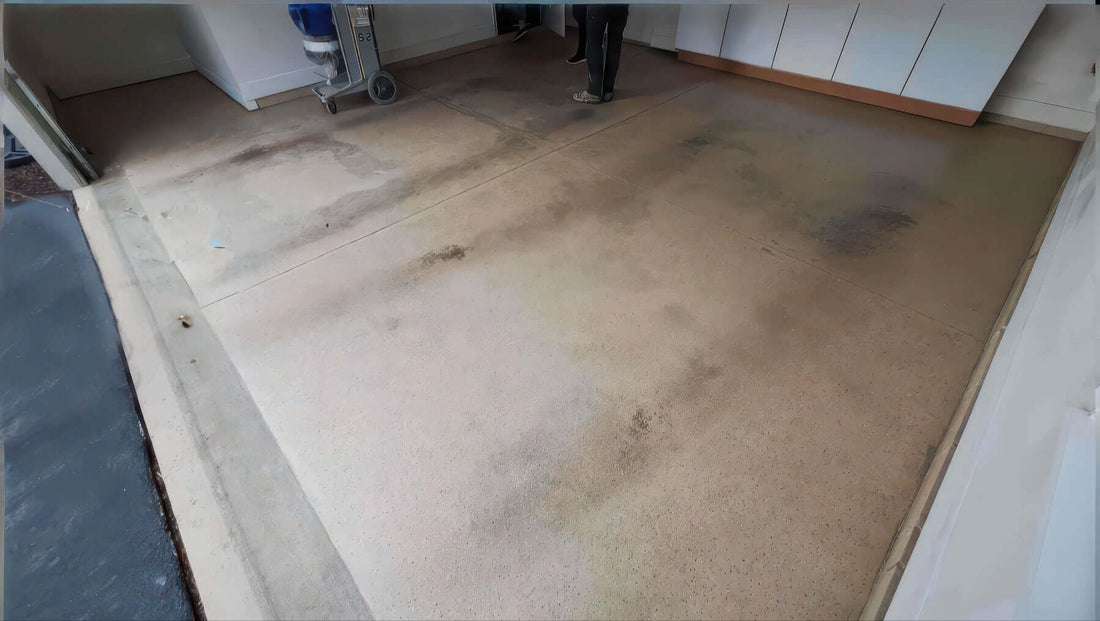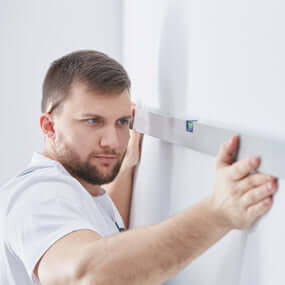The garage floor coating industry has built a billion-dollar business on products that fail before your car loan does.
Painting your garage floor isn't a weekend project—it's a commitment to repeat the process every few years for the life of your home. Epoxy coating will fail too, but you'll have to call a professional back to attempt a fix. There's a reason why the coating products you buy at the big box stores offer no real warranty.
If you're exploring garage flooring options, understanding why coatings fail will save you thousands of dollars and countless hours of frustration. Here are ten reasons why garage floor coatings rarely live up to their promises.
1. Paint or Epoxy Require Difficult Preparation to Avoid Immediate Failure
Walk into any big box store, and the display will show you a pristine garage floor transformed in just hours. What they won't show you is the grueling prep work that determines whether your coating lasts two years or two months.
Contamination is everywhere on garage floors. Oil spots from that decade-old leak. Antifreeze drips from last winter. Tire residue ground into the concrete. Each contaminant creates a barrier between your coating and the concrete, guaranteeing adhesion failure.
Some companies will tell you prep can be done with an acid etch (Big box kits often include the acid). Any professional installer will tell you acid is not good enough and will cause early failure. Proper prep means grinding the entire surface. This creates a cloud of concrete dust that requires respirators, and settles on every shelf, tool, and stored item in your garage. You'll spend more time cleaning up the prep than actually applying the coating.

If that doesn't sound like the way you want to spend a weekend or so, consider interlocking garage floor tiles that need no prep. Sweep the floor, and you're ready to install.
2. Both Require You to Remove EVERYTHING Off the Floor for Days
Planning to coat your garage floor over the weekend? You'll need to empty your entire garage first—and keep it empty for 72 hours minimum.
That riding mower weighing 400 pounds? Move it. Those metal garage cabinets packed with tools? Empty and relocate them. The kids' bikes, your spouse's garden supplies, the holiday decorations—everything goes.
You cannot paint half the floor, shuffle your belongings to the completed side, then finish the rest. Coatings require continuous application across the entire surface, plus full cure time before you can walk on them, let alone place heavy items back.
For most families, this means renting a storage unit, a pod, or cramming everything into the driveway under tarps, praying it doesn't rain. Meanwhile, you're blocked from parking inside for three to five days.

Garage floor tiles can be installed section by section. Clear one area, lay the tiles, move your items onto the finished section, then complete the rest. Your garage remains functional throughout the installation.
3. Coatings Require Good Weather to Apply
Check the weather forecast for your area over the next three days. Is every day between 50°F and 90°F? Is humidity below 85% for all 72 hours? Will there be zero chance of morning dew or overnight temperature drops?
If you answered no to any of these questions, you cannot apply garage floor coating today.
Temperature and humidity affect every stage of the coating process. Too cold, and the product won't cure properly. Too hot, and it cures too fast, creating bubbles and adhesion problems. High humidity traps moisture in the concrete, preventing proper bonding.
The floor must be completely dry after cleaning—not just surface dry, but deep-concrete dry. In humid climates, this can take two to three days after washing. In spring and fall, you might wait weeks for the right weather window. Note that professional installers often bend these rules to stay on schedule.

Garage flooring tiles install in any weather. Rain, snow, or sweltering heat—the installation timeline depends on your schedule, not Mother Nature's.
4. Hot Tires Will Not Be Your Friend
Your car sits in traffic on a summer afternoon. The asphalt reaches 145°F, and your tires absorb that heat. You pull into your freshly coated garage, and those hot tires immediately begin breaking down the paint or epoxy bond.
This isn't a rare occurrence—it happens every warm day you drive. Hot tires from normal driving lift paint, leaving tire-shaped patches of bare concrete within the first year. The coating peels away in sheets, following the exact path your wheels take. The coating manufacturers say they have products that resist this, but look at the warranty and the best you get for a failure is a bucket of new paint.
Road grime makes it worse. Tiny rocks embedded in your treads act like sandpaper, grinding through the coating with each turn of the wheel. Salt in winter climates accelerates the deterioration. Within two years, your pristine floor shows wear paths exactly where you park.

Garage floor tiles resist tire damage. The rigid PVC surface doesn't soften under heat, and the textured pattern hides any minor scuffs that do occur.
5. Concrete Moisture Will Cause Failures
Concrete is porous. It absorbs moisture from the ground beneath it through a process called hydrostatic pressure. Even if your concrete looks dry, water vapor continuously moves through it.
Most garage floors sit on a four-inch concrete slab poured directly on compacted soil—no vapor barrier beneath it. Groundwater, seasonal water tables, and even humidity in the soil push moisture up through the slab. This moisture gets trapped beneath your coating, forming bubbles and causing large sections to delaminate.

There is no long-term solution for this problem with coatings. Moisture meters can tell you if your concrete is too wet to coat, but they can't predict what will happen in six months when the water table rises after spring rains.
Professional installers know this, which is why reputable companies walk away from jobs with known moisture issues. The coating will fail, and they'll be asked back for repairs.
Garage flooring tiles don't care about a little dampness. The interlocking design allows water vapor to escape through the seams, preventing the trapped moisture problems that destroy coatings.
6. Common Garage Chemicals Can Cause Tough-to-Repair Damage
Engine oil, antifreeze, brake fluid—these aren't just stains on a coated floor. They're solvents that permanently damage paint and epoxy.
Spill brake fluid on your coated floor and leave it overnight, and you'll find a sticky, discolored mess in the morning that never fully hardens again. Antifreeze creates a similar problem, leaving a permanently tacky area that attracts dirt and never looks clean.

For woodworkers, the dangers multiply. Lacquer thinner, mineral spirits, and paint strippers destroy garage floor coatings on contact. A single spill from refinishing furniture can ruin a section of floor that costs hundreds to repair.
The damage isn't always immediate, which makes it worse. Some chemicals slowly soften the coating over weeks, creating a sticky trap for dirt and debris. By the time you notice the problem, the damage has spread beyond the original spill area.
Garage floor tile is far more resistant to chemical damage, and if a tile does get damaged, you can replace that single tile in a few minutes without any special tools or skills.
7. Sunlight from the Open Door Will Cause Fading and Yellowing
That bright white epoxy coating looks spectacular on installation day. Drive past the same garage two years later with the door open, and you'll see a yellowed rectangle exactly where the sunlight hits the floor.
Most garage floor coatings lack adequate UV protection. The same sun that fades your deck furniture and car dashboard works on your floor coating every time you open the garage door. The damage accumulates slowly but irreversibly.
Clear epoxy topcoats yellow first, turning amber in high-sunlight areas. Colored coatings fade unevenly, creating a mottled appearance that makes your floor look worse than bare concrete. The decorative flakes in epoxy systems hide some of the discoloration, but they can't stop it.
Age makes coatings brittle. The same UV exposure that causes fading also breaks down the chemical bonds in the coating. After three to five years, you'll notice small cracks forming, typically starting where sunlight hits hardest. These cracks expand with temperature changes, creating a spiderweb pattern across your floor.
Best garage floor tiles have commercial-grade UV protection and maintain their appearance for 15-20 years. The rigid PVC material doesn't become brittle with age, and the color goes through the entire tile thickness, so surface wear doesn't reveal a different color underneath.
8. Coatings on Cracking Concrete Will Also Crack
Concrete cracks. This isn't a defect—it's the nature of the material. As the earth settles under your home, hairline cracks appear in the slab. Temperature changes cause the concrete to expand and contract, creating new cracks each year.
A coating does nothing to hide or prevent these cracks. When a new crack appears beneath your painted floor, the coating splits along the same line, creating an even more visible defect. The crack edges become pathways for moisture infiltration, causing the coating to lift on both sides of the split.
Attempting to fill cracks before coating rarely works long-term. Crack fillers and concrete patches cure at different rates than the surrounding concrete, creating weak points where coatings fail first. The filled crack often becomes more visible than the original defect.
As cracks widen with seasonal temperature swings, moisture gets under the edge of the coating, causing it to lift in increasingly larger sections. What started as a hairline crack becomes a coating failure measured in square feet.
With garage floor tiles, you will never see any of the cracks that may appear in your concrete. The tiles bridge over surface imperfections, and their flexibility accommodates the minor movement that creates cracks in rigid coatings.
9. When Things Go Wrong, Coatings Are Awful to Remove
The coating has failed in your high-traffic areas. You need to fix it, but your options are limited and expensive.
With paint, touchups never match in color. The UV exposure has faded your original coating just enough that the new paint looks noticeably different, even from the same can. The worn surface rarely provides good adhesion for new coating, so your patch begins failing within months.
For small damaged areas, you might try spot repairs. But painted concrete is notoriously difficult to prep for recoating. The new paint tends to peel at the edges, making the repair increasingly larger with each attempt.
With epoxy, there is no DIY-friendly repair. Grinding off the damaged section without affecting the surrounding areas requires professional equipment. Most homeowners end up coating over the problem, which adds thickness and creates a visible patch that never blends with the original surface.

Full removal means renting a floor grinder and creating a concrete dust storm that makes the original prep work seem pleasant. You'll spend an entire weekend grinding, only to discover that some sections of coating refuse to release without damaging the concrete beneath.
With garage floor tile, you can make an invisible repair in a few minutes. Pop out the damaged tile, click in a new one, and the repair is indistinguishable from the original installation.
10. Coatings Are Permanent, Tiles Are Not
Deciding to remove your garage floor coating means committing to a major renovation project. The only effective removal method requires a concrete grinder with diamond blades—a tool rental that costs $200-300 per day, assuming you already have a needed shopvac.
Grinding creates clouds of fine concrete dust that infiltrates every corner of your garage and adjacent living spaces. Professional remediation companies exist specifically for this type of cleanup. The dust contains silica, requiring proper respiratory protection during removal.
Even after grinding, the concrete surface will look worse than before you coated it. The grinder leaves swirl marks and exposes aggregate unevenly, creating a mottled appearance. You'll need to patch and potentially resurface the entire slab before attempting any new flooring solution.
Garage flooring tiles can be removed at any time easily. The interlocking system releases with minimal effort, leaving your concrete in its original condition. Planning to move? Tiles can even be transferred to your new home—try doing that with a painted floor.

The flexibility matters beyond just removal. Maybe you'll convert your garage to a home gym in five years, or your teenager will want to use it as a band practice space. With coated floors, you're locked into that decision. With tiles, you adapt as your needs change.
Frequently Asked Questions
Paint typically lasts 1-3 years in high-traffic areas before requiring recoating, while DIY epoxy systems last 3-5 years. Professional-grade epoxy might reach 7-10 years with careful maintenance. Quality interlocking garage floor tiles last 15-20 years or longer with no maintenance beyond regular cleaning. The key difference: coatings degrade gradually and require complete removal and reapplication, while tiles maintain their appearance and can have individual sections replaced if needed.
A professional painted floor for a two car garage typically costs $540-$1000, but only lasts a couple of years. A DIY epoxy coating kit costs $200-500 for a two-car garage, but factor in prep materials, equipment rental (concrete floor grinders are $200-300/day), pod rental ($150-$350 for a one month minimum) and your time (easily 20-30 hours). Professional installation epoxy for a typical 2 car garage runs $1,300-$5,500. Note that the lower the quote or the time they say it will take, the less of that important prep you are getting. You'll repeat this expense every 3-7 years. Quality garage floor tiles cost $2-8 per square foot ($900-$3,400 for a typical 2 car garage), but that's a one-time expense for 15-20 years of use. Over a 20-year period, coatings cost way more when you account for multiple reapplications.
Coatings create a surface layer only 3-20 mils thick (about the thickness of a few sheets of paper). Point loads from jack stands, cabinet legs, or workbench feet concentrate pressure on tiny areas, causing coatings to crack and delaminate around the contact points. Moving garage storage cabinets across coated floors often peels the coating in sheets. Tiles distribute weight across interlocking sections and resist point-load damage far better than thin coatings.
Concrete, coating materials, and the adhesive layer all expand and contract at different rates with temperature changes. In climates where garage temperatures swing from 20°F in winter to 110°F in summer, this differential expansion creates stress that leads to coating failure. The coating may separate from the concrete, bubble, or crack along stress lines. This problem worsens in attached garages where one side stays warmer than the other. Tiles accommodate temperature movement through their interlocking design without adhesive failure.
Coating might work if you have a heated garage that stays between 60-75°F year-round, never park vehicles inside, have no moisture issues, and perform only light hobby work with no chemicals. For example, a garage that has been converted to a family room (but do you really want a painted floor in your family room?) Essentially, if your garage functions more like a climate-controlled room than an actual garage, coatings become viable. For everyone else—those who park cars, work on projects, live in areas with weather, and use their garage as an actual workshop—garage flooring tiles provide better long-term value and performance.





